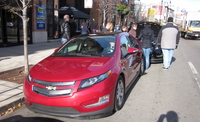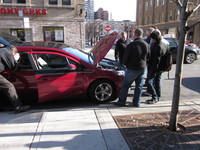2011 Chevrolet Volt: Is it A Best Buy?
SEE ALSO: Chevrolet Buyers Guide
COMPARE: 2011 Chevrolet Volt Vs. 2011 Nissan Leaf
2011 Chevrolet Volt: Is it A Best Buy?
A Quick First Drive.
By Larry Nutson
Senior Editor, Chicago Bureau
The Auto Channel
Chicago, IL November, 2010. Chicago was the final stop in the Volt Unplugged 12-city tour showcasing the functionality and capability of the Chevrolet Volt, the world’s first electric vehicle with extended-range capability. Wrapping up a hat-trick, award filled week wherein the Chevy Volt was named the Green Car of the Year, Motor Trend Car of the Year and Automobile magazine Automobile of the Year, Chicagoans got a first-drive in this car that I think is very suited for urban, big-city living.
It was my first chance to get behind the wheel, being an average interested consumer and asking questions of the Volt engineer who rode along and explained how the Volt worked. When I “lit-up” the Volt, the cockpit display told me I had 18 miles of driving left in the battery. Depending on weather, driving patterns and other stuff, a Volt can get between 25 and 50 miles on a fully charged battery. In Chicago like many large cities, driving is often about negotiating streets in short distances from stop sign to stop sign. The “L” mode in the drive selector is really suited for this type of driving because of the braking action due to the re-gen charging of the battery.
 |
With nearly silent operation, a quick pull on the turn signal stalk sounds a “city-friendly” beep to warn unaware pedestrians of the Volt’s presence. Perhaps this feature should be on all cars to help alleviate the blasting horn that is often so unnecessary.
The Volt has all the stuff you would expect to find in a typical gasoline-powered or hybrid car including a Bose sound system, power windows and power outside mirrors. No power seats however, since they would add about 25 lbs per seat to an already heavy car.
 |
I was told that if the outside temperature is below 20 degrees F the engine will come on to re-heat the passenger cabin and then shut off.
Which brings me to the subject of charging. We’ve heard a lot about charging at home using off-peak electricity over night. In my view, corporations, businesses, and public parking garages need to install charging stations so that we can commute to work and charge the car’s battery all day long. However, charging shouldn’t be free. Simply swipe your credit/debit card or perhaps a corporate ID at work to deduct the cost from your paycheck. I believe we’ll get to this through various initiatives that are now in the works.
According to Chevrolet, fully charging the Volt battery five days a week for a year will use an estimated 2,730kWh, which is less than a quarter of the 11,040 kWh of electricity consumed by the average U.S. household annually.
Chevrolet is introducing the Volt in selected launch markets. California, Texas, Michigan, New York, New Jersey, Connecticut and Washington, DC will get them first. As I write this, the Volt is in production and cars are ready to be shipped to dealers as soon as the US EPA decides on what should appear on the Federal-mandated fuel economy label.
With a $41,000 base MSRP the Volt is pricey. A $7500 federal tax credit is available, that is, if you qualify. Also, I don’t think you’ll see that until you file your federal tax return for the year of purchase. Leasing might just be the better way to go if you don’t have all of the up-front cash. The ROI could take 10 years to recover.
 |
© Larry Nutson




